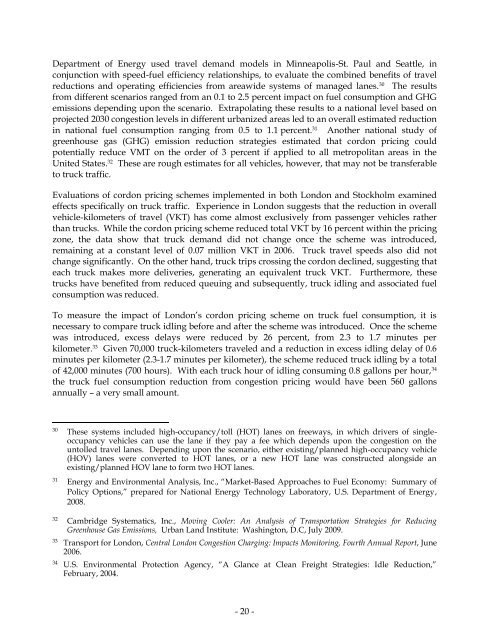Assessment of Fuel Economy Technologies for Medium and Heavy ...
Assessment of Fuel Economy Technologies for Medium and Heavy ...
Assessment of Fuel Economy Technologies for Medium and Heavy ...
Create successful ePaper yourself
Turn your PDF publications into a flip-book with our unique Google optimized e-Paper software.
Department <strong>of</strong> Energy used travel dem<strong>and</strong> models in Minneapolis-St. Paul <strong>and</strong> Seattle, in<br />
conjunction with speed-fuel efficiency relationships, to evaluate the combined benefits <strong>of</strong> travel<br />
reductions <strong>and</strong> operating efficiencies from areawide systems <strong>of</strong> managed lanes. 30 The results<br />
from different scenarios ranged from an 0.1 to 2.5 percent impact on fuel consumption <strong>and</strong> GHG<br />
emissions depending upon the scenario. Extrapolating these results to a national level based on<br />
projected 2030 congestion levels in different urbanized areas led to an overall estimated reduction<br />
in national fuel consumption ranging from 0.5 to 1.1 percent. 31 Another national study <strong>of</strong><br />
greenhouse gas (GHG) emission reduction strategies estimated that cordon pricing could<br />
potentially reduce VMT on the order <strong>of</strong> 3 percent if applied to all metropolitan areas in the<br />
United States. 32 These are rough estimates <strong>for</strong> all vehicles, however, that may not be transferable<br />
to truck traffic.<br />
Evaluations <strong>of</strong> cordon pricing schemes implemented in both London <strong>and</strong> Stockholm examined<br />
effects specifically on truck traffic. Experience in London suggests that the reduction in overall<br />
vehicle-kilometers <strong>of</strong> travel (VKT) has come almost exclusively from passenger vehicles rather<br />
than trucks. While the cordon pricing scheme reduced total VKT by 16 percent within the pricing<br />
zone, the data show that truck dem<strong>and</strong> did not change once the scheme was introduced,<br />
remaining at a constant level <strong>of</strong> 0.07 million VKT in 2006. Truck travel speeds also did not<br />
change significantly. On the other h<strong>and</strong>, truck trips crossing the cordon declined, suggesting that<br />
each truck makes more deliveries, generating an equivalent truck VKT. Furthermore, these<br />
trucks have benefited from reduced queuing <strong>and</strong> subsequently, truck idling <strong>and</strong> associated fuel<br />
consumption was reduced.<br />
To measure the impact <strong>of</strong> London‘s cordon pricing scheme on truck fuel consumption, it is<br />
necessary to compare truck idling be<strong>for</strong>e <strong>and</strong> after the scheme was introduced. Once the scheme<br />
was introduced, excess delays were reduced by 26 percent, from 2.3 to 1.7 minutes per<br />
kilometer. 33 Given 70,000 truck-kilometers traveled <strong>and</strong> a reduction in excess idling delay <strong>of</strong> 0.6<br />
minutes per kilometer (2.3-1.7 minutes per kilometer), the scheme reduced truck idling by a total<br />
<strong>of</strong> 42,000 minutes (700 hours). With each truck hour <strong>of</strong> idling consuming 0.8 gallons per hour, 34<br />
the truck fuel consumption reduction from congestion pricing would have been 560 gallons<br />
annually – a very small amount.<br />
30<br />
These systems included high-occupancy/toll (HOT) lanes on freeways, in which drivers <strong>of</strong> singleoccupancy<br />
vehicles can use the lane if they pay a fee which depends upon the congestion on the<br />
untolled travel lanes. Depending upon the scenario, either existing/planned high-occupancy vehicle<br />
(HOV) lanes were converted to HOT lanes, or a new HOT lane was constructed alongside an<br />
existing/planned HOV lane to <strong>for</strong>m two HOT lanes.<br />
31<br />
Energy <strong>and</strong> Environmental Analysis, Inc., ―Market-Based Approaches to <strong>Fuel</strong> <strong>Economy</strong>: Summary <strong>of</strong><br />
Policy Options,‖ prepared <strong>for</strong> National Energy Technology Laboratory, U.S. Department <strong>of</strong> Energy,<br />
2008.<br />
32<br />
Cambridge Systematics, Inc., Moving Cooler: An Analysis <strong>of</strong> Transportation Strategies <strong>for</strong> Reducing<br />
Greenhouse Gas Emissions, Urban L<strong>and</strong> Institute: Washington, D.C, July 2009.<br />
33<br />
Transport <strong>for</strong> London, Central London Congestion Charging: Impacts Monitoring, Fourth Annual Report, June<br />
2006.<br />
34<br />
U.S. Environmental Protection Agency, ―A Glance at Clean Freight Strategies: Idle Reduction,‖<br />
February, 2004.<br />
- 20 -
















